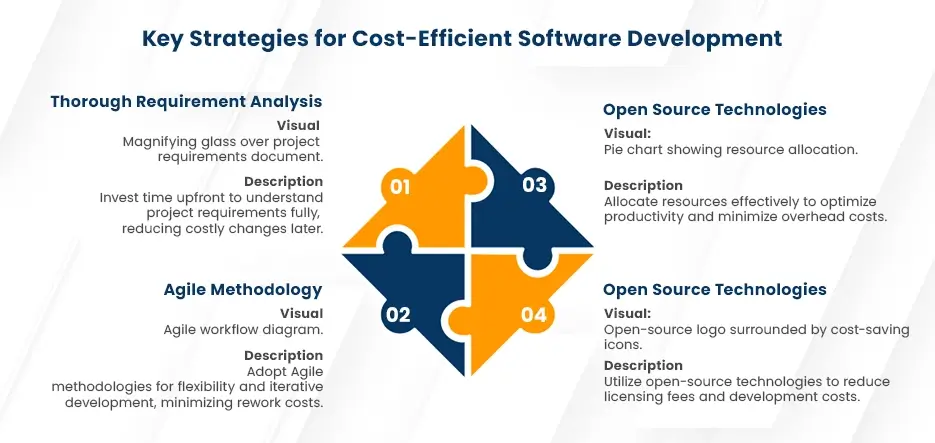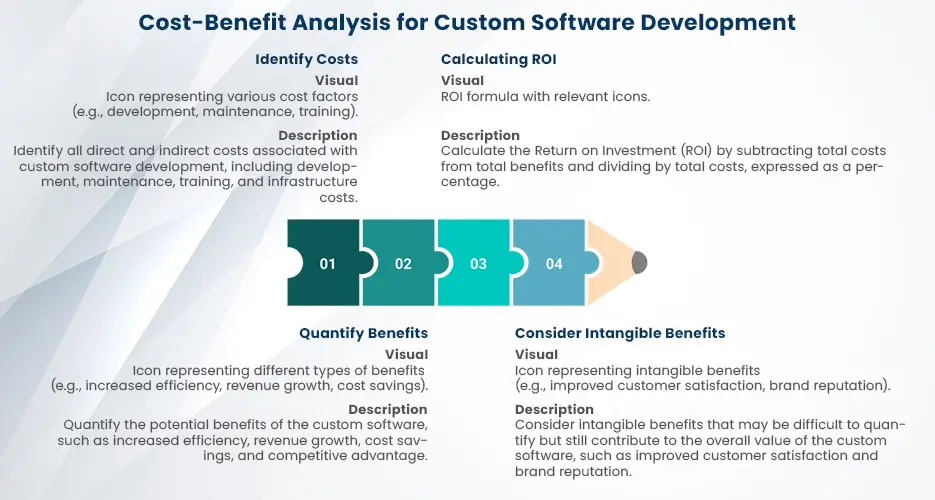Table of Contents
In 2025, optimizing costs remains a top priority for businesses investing in custom software development projects. The landscape of custom software development cost is advancing quickly, with cost-effectiveness turning out to be progressively crucial in developing competition and economic fluctuations.
As indicated by industry reports, the costs associated with custom software development can fluctuate altogether. Based on project complexity, technology stack, development methodology, and geographical location. Custom software project costs vary based on project scale and complexity, influenced by required technologies. Below is a table of estimated costs, subject to project-specific factors.
So.No. Project Size Estimated Cost
1 Small Projects $10,000 to $50,000
2 Medium Sized Projects $50,000 to $200,000
3 Large-scale enterprise solutions $200,000 and beyond
Hourly rates for custom software development benefits ordinarily range from $50 to $250 each hour, contingent upon skill and location. These costs are impacted by factors, for example, project requirements, technology stack, and geographic location. Businesses need to consider these factors while planning for custom software development drives. By and large, the cost of custom software development can go from several thousand to millions of dollars, contingent upon project requirements and specifications.
In this powerful climate, businesses are looking for proven strategies to optimize custom software development costs while guaranteeing high-quality results. However, this guide frames 15+ noteworthy steps and best practices tailored to 2025, engaging businesses to explore cost of custom software development effectively and accomplish ideal outcomes in custom software development projects.
Get Started: Calculate Your Custom Software Development Costs
What Constitutes Custom Software Development?
Custom software development alludes to the process of making tailored software applications specifically designed to meet the extraordinary necessities and requirements of a specific business or association. As compared to off-the-shelf software solutions that are pre-packaged and designed to address general business needs, software development best practices include making tailor-made applications without any preparation or changing existing software to suit specific business processes, workflows, and goals.
The process of custom software development ordinarily starts with a comprehensive analysis of the client’s requirements, incorporating an inside and out understanding of their business objectives. With the target audience, existing systems, and operational challenges. Custom software development can be ordered into several important stages:
1. Requirement Analysis and Planning
- In this phase, the development group leads an exhaustive analysis of the software development strategy and client’s requirements, business objectives, and operational challenges.
- Key partners team up to characterize the scope of the project and lay out clear goals for the software application.
2. Design and Architecture
- During this phase, the development group makes wireframes, mockups, and prototypes. To imagine the format, functionality, and client experience of the software application.
- Designers and architects team up to design the general architecture and UI of the software, focusing on usability and intuitive navigation.
3. Implementation and Development
- In this phase, developers compose code, coordinate different modules and parts, and assemble the software application as per the characterized specifications.
- Development teams follow agile or iterative development methodologies, allowing for continuous input and refinement throughout the development process.
4. Quality Assurance and Testing
- Quality assurance engineers lead thorough testing to guarantee that the software fulfills the highest guidelines of execution, dependability, and security.
- Testing activities incorporate utilitarian testing, convenience testing, execution testing, and security testing to distinguish and resolve any issues or bugs.
5. Deployment and Release
- When the software application is entirely tried and approved, it is conveyed to the creation climate and made available to the end user.
- Custom software development consulting deployment teams guarantee smooth progress to the creation climate and offer help during the underlying rollout stage.
6. Post-Deployment Support and Maintenance
- After deployment, the development group offers continuous help and maintenance administrations. To guarantee the proceeds with execution, scalability, and security of the software application.
- This might incorporate bug fixes, software updates, and specialized support. To resolve any issues or worries that emerge during the utilization of the software.
By separating the custom software development process into these particular stages, development teams can effectively manage projects, moderate risks, and convey high-quality software solutions that meet the interesting necessities and requirements of their clients

Why Invest in Custom Software Development?
Investing in custom software development offers various advantages and advantages for businesses across different ventures. The following are several convincing justifications for why enterprise software development companies decide to invest in custom software development:
1. Tailored Solutions
Custom software development allows businesses to make solutions that are specifically tailored to their remarkable necessities, requirements, and workflows. Not at all like off-the-shelf software, custom solutions can be designed and created to address specific challenges and amazing open doors inside the association.
2. Increased Efficiency and Productivity
Custom software applications are designed in light of the association’s workflow and processes, prompting increased efficiency and productivity. Via automating repetitive errands, streamlining workflows, and eliminating manual processes, custom software solutions empower representatives to zero in on more strategic and value-added activities.
3. Scalability and Flexibility
Custom software solutions are worked to scale with the association as it develops and advances. Dissimilar to off-the-shelf software, which might have impediments as far as scalability and customization, custom software solutions for fintech software development companies can be effortlessly adjusted and expanded to oblige changing business needs and requirements.
4. Competitive Advantage
Custom software development can furnish businesses with a competitive advantage in the commercial center. By offering extraordinary features, functionalities, and client encounters. Custom software solutions can separate businesses from their rivals and draw in customers who esteem advancement and customization.
5. Integration with Existing Systems
Custom software solutions can be seamlessly incorporated with existing systems and technologies inside the association. Whether it’s incorporating outsider applications, information bases, or heritage systems. Custom solutions guarantee smooth interoperability and information trade across the association.
6. Enhanced Security and Compliance
Custom software solutions can be designed with strong security features and compliance measures to safeguard delicate information and guarantee regulatory compliance. By implementing encryption, access controls, and authentication instruments, custom solutions assist with alleviating security risks and defending against information breaks.
7. Cost Savings over the Long Haul
While the underlying investment in custom software development might appear to be higher than buying off-the-shelf software, custom solutions frequently give cost savings over the long haul. Custom software wipes out the requirement for costly permitting charges, continuous memberships, and costly customization efforts associated with off-the-shelf solutions.
8. Ownership and Control
With custom software solutions, businesses have full ownership and control over the development process, protected innovation, and future improvements. This allows custom software development services to make strategic choices and prioritize features and functionalities based on their novel requirements and needs.
Investing in custom software development offers businesses a strategic advantage by giving tailored solutions that upgrade efficiency, scalability, security, and competitive situating in the commercial center. By adjusting technology to business targets and leveraging the advantages of customization. Businesses can drive advancement, development, and progress in the present unique business landscape.
Exploring The Importance of Custom Software Development
Exploring the importance of custom software development uncovers an extraordinary chance for businesses to optimize their tasks and open competitive advantages. As indicated by a report by Forrester, custom software solutions fundamentally affect business efficiency and productivity. With tailored applications streamlining workflows and reducing manual efforts by up to 40%. Custom software offers scalability and flexibility, allowing businesses to adjust to advancing business sector demands and scale their tasks seamlessly.
Besides, a review led by Statista highlights that 79% of businesses prioritize custom software development to address specific challenges and gain a competitive advantage. Custom solutions empower businesses to coordinate with existing systems and technologies, cultivating cooperation and data-driven decision-production processes.
With full ownership and control over the development process, businesses can implement software development strategy with security measures and compliance standards tailored to their industry and regulatory requirements, alleviating the risk of information breaks and guaranteeing regulatory compliance. Fundamentally, custom software development enables businesses to enhance, optimize processes, and drive sustainable development in the present computerized landscape.
Understanding The Dynamics of Custom Software Development Cost
Understanding the dynamics of custom software development cost requires a comprehensive analysis of different factors that impact project costs. As per research by Gartner, roughly 66% of custom software projects surpass their underlying budget because of scope creep and changing requirements during the development process. This highlights the importance of careful planning and requirement gathering to alleviate cost overwhelms.
Furthermore, the complexity of the software solution assumes a critical part in deciding development costs. As per McKinsey, software projects with high complexity levels will generally have higher development costs, as they require greater planning, development, and testing efforts. Furthermore, the decision of technology stack and development tools can affect costs altogether. Utilizing restrictive software or advanced technologies might entail higher authorizing charges and development costs contrasted with open-source other options.
In addition, project management and communication overheads add to cost dynamics, with effective project management practices assisting with limiting costs and guaranteeing ideal project conveyance. Generally, understanding the complicated dynamics for any custom software development consulting for custom software development cost includes cautious thought of project scope, complexity, technology decisions, and project management practices to guarantee fruitful project results inside spending plan constraints.
Key Factors Influencing Custom Software Development Cost
Key factors influencing custom software development costs include:
1. Project Scope and Complexity
Research by Forrester shows that 75% of software development costs are credited to project scope and complexity. Projects with broad features and functionalities commonly require greater development time and resources, bringing about higher costs.
2. Technology Stack and Tools
As per a review by Stack Overflow, 58.7% of developers consider the technology stack as a critical figure for project cost assessment. Exclusive software and advanced technologies might cause higher authorizing charges and development costs contrasted with open-source other options.
3. Resource Allocation and Talent
The availability and ability of talented developers fundamentally influence development costs. Research by McKinsey recommends that work costs represent around 50-75% of software development costs. Employing experienced developers might bring about higher hourly rates however can prompt higher-quality software.
4. Project Management and Communication
Inefficient project management practices can prompt cost overwhelms and delays. As per PMI’s report, miscommunication brings about project failure 57% of the time. Implementing effective project management methodologies can optimize resource allocation and limit superfluous costs.
5. Customization and Integration Requirements
Customization and integration need to add to development costs, with complex integrations and customizations requiring extra development exertion and resources. A concentrate by TechRepublic recommends that 65% of software development spending plans be distributed to customization and integration errands.
6. Testing and Quality Assurance
As per research by Capgemini, software solutions cost businesses around $5.2 trillion every year. Investing in comprehensive testing and quality assurance processes can help recognize and redress gives from the get-go in the development lifecycle, reducing the general cost of software development.
7. Regulatory Compliance and Security Measures
Compliance with industry guidelines and security standards adds to development costs. A concentrate by IBM gauges that the typical cost of a data break is $3.86 million. Implementing vigorous security measures and guaranteeing regulatory compliance is essential for relieving risks and safeguarding delicate data.
By taking into account these key factors and integrating them into the software development planning process, custom software development for startups can effectively manage costs and convey fruitful custom software solutions that meet their targets and requirements.
How to Effectively Manage Custom Software Development Costs
Effectively managing custom software development costs requires cautious planning, strategic decision-production, and proactive cost-control measures. Here are a few strategies to manage custom software development costs:
1. Define Clear Project Requirements
Research recommends that up to 40% of project costs can be due to unclear or evolving requirements. By characterizing clear and detailed project requirements upfront, businesses can limit scope creep and stay away from costly changes during the development process.
2. Adopt Agile Development Methodologies
Agile methodologies, like Scrum and Kanban, advance iterative development and regular input cycles. Studies have shown that agile projects are 28% more effective than customary projects, with quicker time-to-showcase and diminished development costs.
3. Prioritize Features and Functionality
Prioritizing features based on business worth and criticality can assist with zeroing in on development efforts in high-influence regions. The Pareto Principle recommends that 80% of results from 20% of efforts, accentuate the importance of prioritization in cost-effective software development.
4. Utilize Open-Source Technologies
Open-source technologies offer cost-effective options in contrast to exclusive software solutions. By leveraging open-source frameworks, libraries, and tools, businesses can lessen permitting expenses and development costs. While profiting from local area support and solutions for custom software development services.
5. Optimize Resource Allocation
Effective resource allocation includes matching the right abilities and skills to project requirements. Studies have demonstrated the way that legitimate resource allocation can prompt a 20% increment in productivity and a 10% decrease in project costs.
6. Implement Continuous Integration and Testing
Continuous integration and testing practices help recognize and amend give from the get-go in the development lifecycle. Reducing the cost of revising and troubleshooting. Research demonstrates that implementing continuous integration can prompt a 90% decrease in integration issues and a 75% decline in testing time.
7. Monitor and Track Costs Regularly
Laying out strong cost monitoring and tracking instruments allows businesses to distinguish cost differences. Deviations from the spending plan almost immediately like in the case of spending on artificial intelligence in software development. By tracking project costs against planned expenses, businesses can make remedial moves and pursue informed choices to hold costs in line.
8. Negotiate Transparent Contracts with Vendors
While outsourcing development assignments or connecting outsider vendors, negotiating transparent contracts with clear expectations, courses of events, and is essential to cost structures. Transparent contracts assist with staying away from startling costs and misunderstandings, encouraging a cooperative and cost-effective organization.
By implementing these strategies and leveraging data-driven experiences, businesses can effectively manage custom software development cost while conveying high-quality solutions that meet their goals and monetary constraints.
15 Essential Strategies to Optimize Custom Software Development Cost in 2025
In the quickly advancing landscape of technology, custom software development has turned into a basic apparatus for businesses striving to remain on the ball. However, as the demand for tailored solutions keeps on rising, so does the pressure to effectively manage costs. In the year 2025, optimizing custom software development cost remains a first concern for associations trying to expand the return on initial capital investment and drive sustainable development.
To navigate this complex terrain, businesses should adopt a strategic methodology that offsets development with fiscal responsibility. In this guide, we delve into 15 essential strategies designed to assist businesses with optimizing custom software development cost in 2025. From characterizing clear project requirements. To leveraging agile methodologies and embracing open-source technologies. These strategies offer noteworthy experiences to enable associations. As they continue looking for cost-effective software solutions. We should investigate how businesses can bridle the force of development. While watching out for the main concern in the unique landscape of custom software development in 2025.
1. Assessing Project Requirements
Before setting out on custom software development, directing a careful evaluation of project requirements is crucial. This includes gathering inputs from partners, understanding business targets, and characterizing clear objectives and expectations. Research demonstrates that 60% of project failures can be credited to inadequately characterized requirements, highlighting the importance of careful evaluation upfront. By assessing project requirements comprehensively, healthcare software development company can stay away from costly modifications and scope changes later in the development process.
2. Choosing The Right Development Methodology
Choosing a suitable development methodology is key to optimizing software development costs. As indicated by the State of Agile Report, associations utilizing Agile methodologies experience 61% quicker time-to-advertise contrasted with conventional methodologies. Various methodologies, like Cascade, Agile, and DevOps, offer particular advantages and challenges. By assessing project complexity, course of events, and flexibility requirements, businesses can pick the methodology the most ideal for their necessities, limiting development costs and augmenting efficiency.
3. Prioritizing Features and Functionality
Prioritizing features and functionality based on business esteem is essential for cost-effective software development. The Pareto Principle proposes that 80% of a software’s worth comes from 20% of its features, stressing the importance of prioritization in cost-effective development. By distinguishing centre functionalities and prioritizing them as indicated by customer needs and market demands. Businesses can zero in on development efforts to convey the most effective features inside the spending plan and timetable constraints.
4. Effective Project Planning and Management
Effective project planning and management are basic for controlling software development costs. Concentrates on showing that projects with effective project management practices are 2.5 times bound to fulfill monetary constraints and time constraints. By laying out clear project objectives, achievements, and timetables, custom software development companies in USA can limit deferrals and spending plans overwhelms. However, implementing powerful project management practices, for example, task tracking, resource allocation, and risk management guarantees projects remain focused and within budget.
5. Leveraging Off-the-Shelf Solutions
Leveraging off-the-shelf solutions and outsider parts can assist with reducing development costs and speed up the chance to advertise. Leveraging off-the-shelf solutions can lessen development costs by up to 40%, as indicated by research by McKinsey and Company. By consolidating prefabricated modules, libraries, and frameworks. Businesses can zero in on development efforts on customizing and coordinating center functionalities, rather than rehashing an already solved problem.
6. Embracing Agile Development Practices
Agile development practices advance iterative development, incessant joint effort, and versatile planning. However, by separating projects into small, manageable additions, businesses can answer changing requirements and market dynamics efficiently. Agile projects are 28% more effective than customary projects, with 75% of associations revealing higher project achievement rates, according to the Agile Partnership. However, agile methodologies cultivate straightforwardness, flexibility, and continuous improvement, bringing about cost-effective and high-quality software solutions.
7. Implementing Continuous Integration and Deployment (CI/CD)
Continuous integration and deployment (CI/CD) automate the process of incorporating code changes and sending applications to creation environments. Associations implementing CI/CD pipelines experience a 200% improvement in deployment recurrence and a 22% decrease in lead time, as per the State of DevOps Report. By streamlining development workflows and reducing manual mediation, CI/CD pipelines. Further develop productivity, diminish mistakes, and speed up the chance to advertise, eventually lowering development costs.
8. Utilizing Automation Tools and Technologies
Automation tools and technologies, like robotic process automation (RPA) and test automation frameworks. Streamline repetitive assignments and speed up development cycles. However, test automation can diminish testing efforts by depending upon 85%, prompting tremendous cost savings over the project lifecycle, as indicated by Capgemini. However, by automating manual processes, businesses can limit human mistakes, further develop efficiency, and diminish development costs over the long run.
9. Optimizing Resource Allocation and Utilization
Optimizing resource allocation includes matching the right abilities and mastery to project requirements. By leveraging a blend of in-house talent, specialists, and outsourcing accomplices, digital transformation service provider can optimize costs while guaranteeing convenient project conveyance and quality results. Legitimate resource allocation can bring about a 20% increment in productivity and a 10% decrease in project costs, as per research by Deloitte.
10. Collaborating with Offshore Development Teams
Collaborating with offshore development teams can offer cost savings and admittance to specialized aptitude. Offshore development teams can offer cost savings of up to 60% compared with in-house development, as detailed by the National Outsourcing Association. By leveraging worldwide talent pools and outsourcing non-centre errands, businesses can decrease development costs without compromising quality or efficiency.
11. Conducting Regular Code Reviews and Quality Assurance
Regular code reviews and quality assurance processes are essential for distinguishing and redressing issues right off the bat in the development lifecycle. However, early imperfection identification through regular code reviews and QA processes can lessen and improve costs by up to 80%, as indicated by the Consortium for IT Software Quality. Moreover, by investing in vigorous testing and QA practices, businesses can limit revamping. To further develop software quality, and lessen by and large development costs.
12. Monitoring and Controlling Project Scope
Monitoring and controlling project scope is basic for preventing scope creep and managing costs effectively. By laying out clear scope limits, reporting requirements changes, and obtaining partner purchases, custom software development companies in USA can guarantee projects keep focused and inside the budget. Effective scope management can diminish project costs by up to 20% and increment customer fulfilment by guaranteeing project expectations line up with partner assumptions, according to the Project Management Organization.
13. Managing Change Requests and Scope Creep
Managing change requests and scope creep requires proactive communication and partner management. Moreover, uncontrolled scope creep can increment project costs by up to 30%, highlighting the importance of proactive change management strategies, as per PMI’s Pulse of the Profession. By assessing the effect of changes on project courses of events, spending plans, and resources, businesses can pursue informed choices and limit the risk of cost overwhelms.
14. Negotiating Contracts and Vendor Agreements
Negotiating contracts and vendor agreements is essential for getting ideal terms and pricing. Effective exchange strategies can bring about cost savings of up to 15% on vendor contracts and agreements, as indicated by research by Gartner. Importantly, by conducting careful vendor assessments, explaining expectations and achievements. Negotiating transparent contracts, businesses can moderate risks and guarantee cost-effective enterprise software development companies.
15. Tracking and Analyzing Project Metrics with Continuous Improvement and Iteration
Tracking project metrics and execution pointers allows businesses to distinguish regions for improvement and optimization. Associations that prioritize data-driven decision-production make 4% higher project progress rates and 10% higher return for capital invested, as per the Project Management Foundation. By analyzing metrics like budget fluctuation, resource utilization, and project velocity, businesses can go with data-driven choices, drive continuous improvement, and optimize software development costs after some time.

Advanced Techniques for Optimizing Custom Software Development Cost in 2025
As businesses keep on looking for inventive solutions while managing their financial plans effectively. With advanced techniques for optimizing custom software development cost have arisen. However, these techniques go past conventional techniques and influence cutting-edge strategies to maximize ROI and minimize expenses. Here are a few advanced techniques for optimizing custom software development cost in 2025:
1. Predictive Cost Modeling
Predictive cost modeling includes using historical project data and advanced examination to figure out project costs precisely. Subsequently, by analyzing past project metrics, for example, resource utilization, development periods, and cost differences, custom software development consulting can go with data-driven choices and anticipate possible cost invaders before they happen.
2. Blockchain Technology for Transparent Contracts
Blockchain development company in USA offers a solid and transparent method for managing contracts and vendor agreements. However, tech contracts executed on blockchain platforms guarantee responsibility, reducing the risk of debates and renegotiations that can expand project costs.
3. AI-Powered Project Management Tools
AI-powered project management tools influence machine learning calculations to optimize resource allocation, predict project courses of events, and distinguish cost-saving open doors. However, these tools break down project data progressively, giving noteworthy experiences to project managers and partners for more educated decision production.
4. Cloud-Based Development Environments
Cloud-based development environments offer scalability, flexibility, and cost-efficiency contrasted with conventional on-premises frameworks. Subsequently, by leveraging cloud administrations for development, testing, and deployment, Businesses can decrease framework costs, streamline tasks, and speed up the chance to showcase custom software solutions.
5. Crowdsourced Testing and QA Platforms
Crowdsourced testing and QA platforms saddle the force of worldwide testing networks to recognize bugs, weaknesses, and ease of use issues in custom software applications. Furthermore, by crowdsourcing testing efforts, businesses can get to different ranges of abilities, lessen testing costs, and guarantee comprehensive test inclusion across different gadgets and platforms.
6. Zero-Code and Low-Code Development Platforms
Zero-code and low-code development platforms enable citizen developers and business clients to make custom software solutions without broad coding information. However, by streamlining the development process and reducing dependence on gifted developers. Businesses can speed up opportunities to market and lower development costs altogether.
7. Strategic Outsourcing and Insourcing Models
Strategic outsourcing and insourcing models empower businesses to use the right blend of in-house talent and outside aptitude to optimize development costs. Moreover, by strategically outsourcing non-centre assignments and insourcing crucial capabilities, digital transformation in healthcare companies can accomplish cost savings while maintaining quality and control over the development process.
8. Robotic Process Automation (RPA) for Development Workflows
Robotic Process Automation (RPA) automates repetitive undertakings and workflows in the development lifecycle, like code age, testing, and deployment. Moreover, via automating manual processes, businesses can further develop efficiency, lessen mistakes, and let loose important engineer time to zero in on high-esteem errands.
9. Continuous Cost Optimization Frameworks
Continuous cost optimization frameworks incorporate cost management practices into the software development lifecycle. However, by laying out clear cost targets, implementing cost monitoring and tracking components, and conducting regular cost optimization reviews, custom software development outsourcing can recognize inefficiencies and wipe out inefficient spending proactively.
10. Advanced Risk Management Strategies
Advanced risk management strategies influence predictive examination and situation planning to moderate project risks and uncertainties. However, by distinguishing potential risk factors right off the bat in the development process. However, businesses can foster emergency courses of action, assign resources effectively, and limit the financial effect of unanticipated occasions on custom software projects.
Integrating these advanced techniques into custom software development projects can assist businesses. With remaining competitive, imaginative, and cost-effective in the powerful landscape of technology-driven solutions in 2025.
In Conclusion: Delving into the Cost Dynamics of Custom Software Development
Exploring the cost dynamics of custom software development uncovers a complex landscape where different factors cross to impact project results. By understanding the intricacies in question and implementing strategic measures. Furthermore, businesses can explore the intricacies of custom software development cost all the more effectively. Moreover, from assessing project requirements and choosing the right development methodologies to leveraging off-the-shelf solutions and embracing agile practices, every viewpoint assumes a crucial part in forming project costs and results.
Businesses should adopt a proactive way to deal with cost management, prioritizing straightforwardness, joint effort, and continuous improvement all through the development lifecycle. However, by cultivating a culture of responsibility and advancement, businesses can relieve risks, optimize resource utilization, and expand the worth obtained from custom software development drives. As technology proceeds to advance and market dynamics shift, remaining sensitive to arising patterns. Moreover, best practices will be fundamental for businesses looking to optimize custom software development costs and drive sustainable development in 2025 and then some.
Frequently Asked Questions (FAQs) about Custom Software Development
1. What are The Typical Cost Ranges for Custom Software Development Projects?
The cost of custom software development projects can fluctuate broadly based on factors like project complexity, required features, and technology stack. Small-scale projects might go from $10,000 to $50,000, while medium-scale projects can cost between $50,000 to $200,000. Large-scale projects, including enterprise-level solutions, may go from $200,000 to several million dollars, contingent upon the scope and requirements.
2. What Factors Influence The Variability in Custom Software Development Cost?
Several factors impact the fluctuation in custom software development cost, including project complexity, wanted features and functionality, technology stack, development course of events, and the degree of customization required. Furthermore, each of these factors adds to the general cost assessment process and can influence the last project’s budget for a custom software development outsourcing company.
3. How can Businesses Optimize Custom Software Development Cost Without Compromising Quality?
Businesses can optimize custom software development cost by prioritizing features based on business needs. Moreover, leveraging existing frameworks and libraries, adopting agile development methodologies to manage changes efficiently, and encouraging clear communication and coordinated effort among partners and development teams. Moreover, conducting exhaustive requirements analysis and looking for competitive offers from various vendors can assist with guaranteeing cost-effective project conveyance.
4. What are Some Common Pitfalls That Can Lead to Unexpected Cost Escalations in Custom Software Development Projects?
Typical complications that lead to unanticipated cost increases include scope creep, inadequate requirements collection, inadequate project management and planning, unclear project expectations and scope, and miscalculation of specialized complexities. However, reducing costs can be achieved by proactively addressing these issues through risk management, frequent monitoring, and good communication.
5. How can Businesses Ensure Transparency and Accountability in Custom Software Development Cost Estimates and Billing?
Businesses can guarantee straightforwardness and responsibility in custom software development cost gauges and charging by laying out clear project targets and requirements forthright. However, negotiating detailed contracts and service-level agreements (SLAs) with development accomplices, tracking project progress against predefined achievements. However, while maintaining open lines of communication with all partners all through the development lifecycle. Furthermore, conducting regular reviews and reviews of project costs and costs can assist in recognizing any discrepancies and guaranteeing solutions with monetary constraints.






